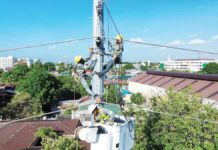ILOILO City – Dengue cases in Western Visayas continue to taper, according to the Department of Health (DOH), in fact they are now below the epidemic threshold.
“I hope this trend will continue up to the end of the year,” said Dr. Glen Alonsabe, DOH Region 6 epidemiologist.
DOH declared a region-wide dengue outbreak on July 15.
Cases started dropping in the first week of August, said Alonsabe. But he stressed the region must not lower its guard.
Dengue is a mosquito-borne viral infection causing a severe flu-like illness that could sometimes be fatal. Its carriers are day-biting mosquitoes (Aedes albpictus and Aedes aegypti) that live and breed and clean, stagnant water.
While all provinces – Iloilo Antique, Aklan, Capiz, Guimaras, and Negros Occidental – showed a downward trend in dengue cases, Alonsabe said there still areas with clustering of cases.
Clustering of cases occur when there are three or more cases in a barangay in four successive weeks.
As of Sept. 21 (38th morbidity week), DOH-6’s Regional Epidemiology and Surveillance Unit recorded 49,130 cases of dengue, with 215 deaths.
Dr. Rosemarie Lamirez, DOH-6 medical
coordinator, said they continue to provide local government units with the
needed logistics to curb the spread of dengue such as mosquito nets and
insecticides.
Dengue fast lanes and hydration units in government hospitals are also being
maintained, Lamirez added.
For her part, Dr. Sophia Pulmones, DOH-6 Health Support Division chief, reminded local chief executives to continue the 4S campaign.
The 4S strategy stands for: search and destroy mosquito breeding places, self-protection measures, seek early consultation for fever lasting more than two days, and say “no” to indiscriminate fogging.
In July, DOH-6 said, people became complacent, thus the surge in dengue cases.
DOH-6 had been issuing public warnings as early as last year about a possible surge in dengue cases, according to Alonsabe, citing the trend observed in recent years – dengue outbreaks tend to occur every three years.
But instead of taking precautionary measures, people became complacent, lamented Alonsabe, perhaps due to the lull in cases in 2018 and 2017.
It was way back in 2016 when the region experienced a dramatic spike in dengue cases, he said.
According to the World Health Organization, individuals should suspect dengue when a high fever (40 degrees centigrade) is accompanied by two of the following symptoms: severe headache, pain behind the eyes, nausea / vomiting, swollen glands, muscle and joint pains, and rash.
For severe dengue, the warning signs to look out for are: severe abdominal pain, persistent vomiting, rapid breathing, bleeding gums, blood in vomit, fatigue, and restlessness./PN



